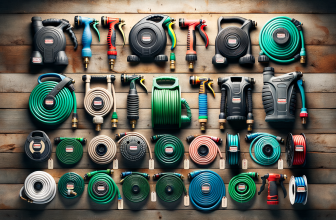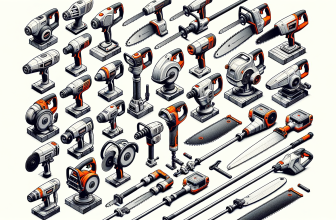
Are you looking for the best chainsaw chain to power through your cutting tasks with ease and precision? Finding the right chain is crucial as it directly impacts the efficiency of your work, the longevity of your chainsaw, and personal safety during operation. Whether you’re tackling large trees, trimming branches, or slicing firewood, the right chain can make a world of difference.
Our Top Picks
Our #1 Top Pick: Oregon S56 AdvanceCut
The Oregon S56 AdvanceCut is the epitome of balance between durability and user-friendliness. Designed for homeowners and occasional users, this 16-inch chain features a 3/8-inch pitch and .050-inch gauge, making it versatile for a range of cutting tasks. The low-vibration, low-kickback design is complemented by the chain’s LubriTec oiling system which helps keep both chain and guide bar oiled, thus reducing friction and extending the life of the chain. This is a product you can rely on for smooth and efficient cuts without excessive strain on your chainsaw.
Pick #2: Husqvarna H30-72 Pixel Saw Chain
Husqvarna is a name that resonates with quality in the chainsaw world. Their H30-72 Pixel Saw Chain is suitable for those who require precision and power. Suitable for 18-inch bars, this chain features a .325-inch pitch and .050-inch gauge. The H30-72 is a high-performance, low-vibration chain with a narrow kerf, which requires less power from the saw than standard cutting systems. As a result, it’s ideal for those who use their saws frequently but want to maintain ease of use and efficiency.
Pick #3: STIHL 26RS 81 Rapid Super
STIHL is synonymous with high-quality chainsaw equipment, and the 26RS 81 Rapid Super is a testament to this reputation. This 20-inch chain is for the professional who demands the highest-quality cutting performance. With its .325-inch pitch and .063-inch gauge, the Rapid Super is designed for aggressive cutting and boasts a full chisel design which allows for precision cutting at high speeds. A special oiling feature ensures that each link in the chain receives consistent lubrication, reducing wear and elongating the life of your investment.
Pick #4: Oregon R34 AdvanceCut
For those with pole saws or smaller chainsaws, look no further than the Oregon R34 AdvanceCut. This 8-inch chain is specifically created for the compact saws and features a 3/8-inch low profile pitch, perfect for lighter-duty tasks. The AdvanceCut series prioritizes safety and control with its low-kickback design while continuing to provide a sharp and efficient cut. It’s a great choice for pruning, limbing, and underbrush clearing. If your work involves trees with thinner barks or less dense wood, this could be the ideal chain for you.
Pick #5: CARLTON K3C-072G Semi-Chisel Chain
The CARLTON K3C-072G Semi-Chisel Chain is for the rugged individual who anticipates cutting in tough conditions. Boasting a semi-chisel design, this chain is less likely to dull when it comes in contact with dirt, debris, or hard objects. Suited for 20-inch chainsaw bars, the chain features a .325-inch pitch and a .063-inch gauge, providing a blend of speed and smooth cutting capability. Despite tough performance, it maintains a low-kickback profile, providing an increased level of safety for the user.
What to Know Before You Buy
- Know Your Chainsaw: Ensure the chain you’re purchasing is compatible with your chainsaw model. Check your user manual or existing chain for information on size and type.
- Chain Types: Understand the different types of chains available—full chisel, semi-chisel, and low-profile—and what tasks they’re suited for.
- Safety Features: Features like low-kickback designs are crucial for safety. Know what safety features your preferred chain offers.
- Maintenance: Some chains require more maintenance than others. Consider how often you’re willing to sharpen and service your chain.
Factors to Consider Before Buying
- Cutting Tasks: Consider what you’ll be cutting most often. Different woods and tasks will require different chains.
- Durability: Look for chains made with high-quality steel and those that offer corrosion resistance for longer life.
- Bar Length: The chain must match the length of your chainsaw’s guide bar—neither too long nor too short.
- Chain Pitch and Gauge: These measurements must be compatible with your chainsaw. The pitch is the distance between the drive links, while the gauge is the thickness of the drive link where it fits into the guide bar.
- Brand Reliability: Consider chains from reputable brands known for quality chainsaw accessories.
Why Trust ChooseRight?
Here at ChooseRight, we’ve meticulously reviewed products, pored over thousands of customer reviews, and garnered feedback from professionals. We commit to providing unbiased and comprehensive reviews to ensure you can make an informed decision. Our team understands that a chainsaw chain is more than just a tool accessory; it’s an investment in your efficiency and safety. We’ve done the heavy lifting so that you can confidently purchase the best chainsaw chain for your needs.
Finishing Thoughts
Equipping yourself with the right chainsaw chain will not only improve your cutting performance but also prolong the life of your chainsaw and ensure safety during use. With our top picks and the buying considerations outlined, we trust that you are now armed with the necessary information to select a chain that will serve you well in your various cutting tasks. Always remember to consult your chainsaw manual, understand the requirements of your cutting tasks, and never compromise on quality and safety. Happy cutting!
Frequently Asked Questions
What makes a chainsaw chain the ‘best’?
The best chainsaw chain depends on the user’s needs and the tasks at hand. Factors include the chain’s durability, sharpness, compatibility with the chainsaw, the type of wood it is best used on, and the cutting performance for tasks such as felling, bucking, or pruning.
How do I determine the right size chain for my chainsaw?
To determine the right size chain for your chainsaw, you need to know the guide bar length, the chain pitch, which is the distance between three consecutive rivets divided by two, and the number of drive links which correspond to the chain’s length.
What is the difference between full chisel and semi-chisel chains?
Full chisel chains have square-cornered teeth, making them fast and efficient for cutting softwoods but more prone to kickback. Semi-chisel chains have rounded teeth, are more tolerant of dirt and debris, and maintain their sharpness longer but may cut slightly slower.
How often do I need to sharpen my chainsaw chain?
The frequency of sharpening a chainsaw chain depends on how often and intensively the chainsaw is used, as well as the material being cut. After every few hours of active use is a common benchmark, but it is also necessary when the chain shows signs of dullness such as requiring more force to cut or producing sawdust instead of chips.
Can I use any brand of chain with my chainsaw?
Not all chains are compatible with every chainsaw. It is important to use chains that are designed for your chainsaw’s specifications, including the proper length, pitch, and gauge. Consult the chainsaw’s manual or the manufacturer’s recommendations to find compatible chains.
What is chain pitch and why is it important?
Chain pitch is the distance between any three consecutive rivets divided by two and it determines the size of the chain. It is important because a mismatched pitch can prevent the chain from fitting onto the chainsaw’s bar or sprocket properly.
How can I tell if my chainsaw chain is dull and needs replacing?
Signs that a chainsaw chain is dull include difficulty in cutting, producing fine sawdust instead of chips, the chainsaw pulling to one side, and visible damage to the chain’s teeth. If sharpening does not improve these issues, it might be time to replace the chain.
Are there specific chainsaw chains recommended for hardwood versus softwood?
Yes, chainsaw chains are designed for different types of wood. For hardwood, a chain with a lower number of teeth might be preferred for efficient cutting while a chain with more teeth may be better for softer woods. However, sharpness and the proper saw power also play significant roles.
How can I avoid chainsaw kickback?
You can avoid kickback by using a chain with low-kickback features, maintaining a sharp chain, ensuring correct chain tension, using proper cutting techniques, and avoiding the kickback zone, which is the upper tip of the chainsaw bar.
What safety equipment should I use when operating a chainsaw?
Whenever operating a chainsaw, you should use proper safety equipment, including a hard hat, safety glasses, hearing protection, gloves, chainsaw chaps or pants, and sturdy boots. Always consult the manufacturer’s instructions and safety guidelines before using a chainsaw.







